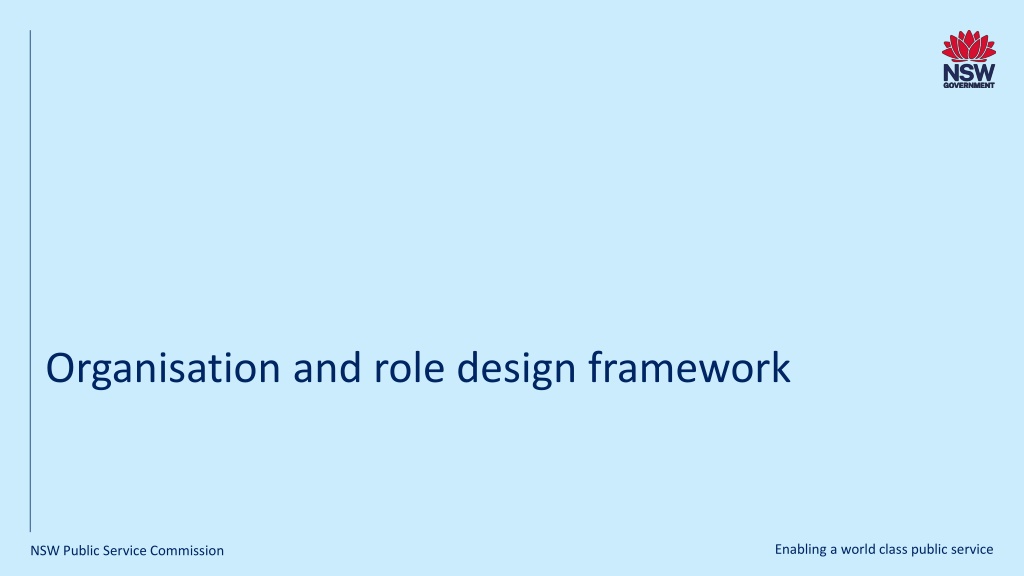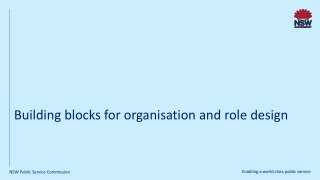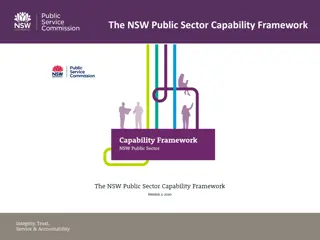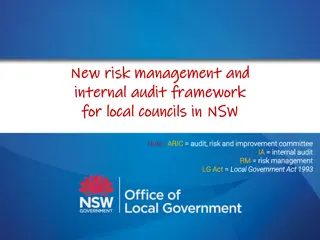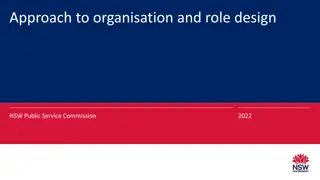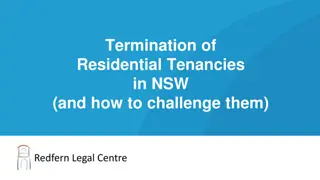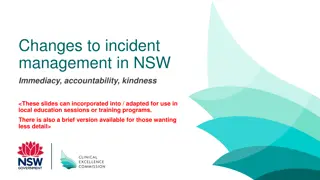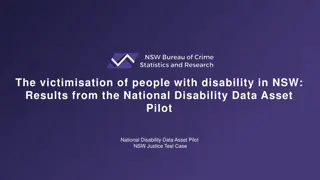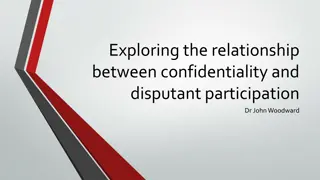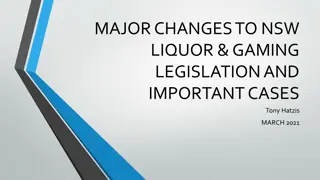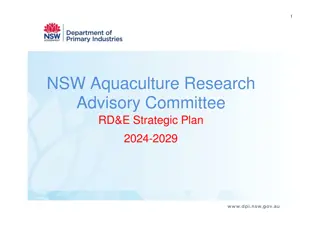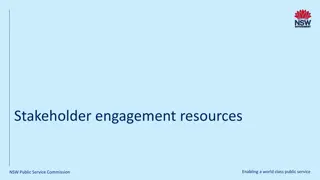Framework for Organisation and Role Design in NSW Public Service
Understand the process of organisation redesign through a comprehensive framework developed in collaboration with experts. Explore the model, key questions, and restructuring overview. Learn about the importance of organisation and role design, and how to enhance role clarity, employee engagement, and workplace culture for effective outcomes.
Download Presentation

Please find below an Image/Link to download the presentation.
The content on the website is provided AS IS for your information and personal use only. It may not be sold, licensed, or shared on other websites without obtaining consent from the author. Download presentation by click this link. If you encounter any issues during the download, it is possible that the publisher has removed the file from their server.
E N D
Presentation Transcript
Organisation and role design framework Enabling a world class public service NSW Public Service Commission
About the framework How to use the Framework This resource will help you understand the organisation redesign process. This Framework includes a model of organisation and role design, questions to consider, and an overview of the organisational restructuring process. Use it when you are contemplating a restructure and would like to explore the range of options available. About the development of the Framework This resource has been developed co-designed in collaboration with Human Resource and organisational change experts across NSW Government. NSW Public Service Commission Enabling a world class public service 2
What is organisation and role design? Organisation design is a process that enables the organisation to work well, deliver results, optimise efficiency, and achieve operational and strategic objectives. Organisation design determines where roles fit into the broader structure and how each role will interact with other roles and teams. Organisation redesign, also commonly referred to as a restructure, realignment or change management process typically refers to changes to an organisation s structure. When preparing for restructures, it s important to consider all the aspects of organisation and role design which includes changes to the organisation's structure, role design, ways of working, processes, delegations and systems. Effective organisation redesign that considers all these aspects will support the organisation with increasing role clarity, employee engagement, collaboration across the organisation, and building a positive workplace culture. Organisation redesign can take a top down approach (strategy first) or a bottom up approach (role analysis) and is driven by the scale, level and complexity of redesign required. Preparing for an organisation redesign process can be complex and challenging. Identifying models and structures that are flexible, adaptable and future-ready requires detailed planning and collaboration with key stakeholders across the organisation. There are many risks in conceptualising and implementing a redesign, so it is important to take a holistic approach and address all the aspects of organisation and role design. Role design is a critical aspect of effective organisation redesign. Role design outlines the key responsibilities and challenges of a role, the way the work is to be done, how it will be done, and the capabilities required by the person who will fill the role. Role design outlines the contribution and value add of the role to the organisation s operational and strategic objectives. Organisation and role design are two sides of the same coin. One informs the other. Enabling a world class public service NSW Public Service Commission 3
DRAFT VERSION Organisation and role design model Organisation design is the process that enables the organisation to work well, deliver results, optimise efficiency, achieve operational and strategic objectives. Organisation design determines where roles fit into the broader structure and how each role will interact with other roles and teams. There are six aspects of an organisation that need to be considered in a restructure to ensure organisational effectiveness. This includes the following: Organisational structure An organisational structure, represented on an organisation chart, is a system that outlines the roles, relationship between roles, reporting lines, and spans of control. Role design Role design define the duties and responsibilities of the role, how the role contributes to the organisation s mission and vision, how the role fits in the organisational structure, what capabilities are needed, challenges of the role and spans of control. Organisational structure Ways of working Ways of working refers to how people within an organisation behave, collaborate, communicate and share information to achieve the organisation s mission and vision. There are four different types of collaboration which fall under two categories: 1) Synchronous work Co-located and working together Distributed and working together 2) Asynchronous work Co-located and working alone Distributed and working alone Systems Role design Organisation and role design Ways of working Processes Processes refers to the series of actions, steps and/or decisions involved in the way work is completed, to achieve a specific result. Delegations Delegations Delegations refer to the responsibility and authority given to a person to carry out specific activities/functions. Processes Systems Systems refer to a way of working, organising or doing something which follows a specific set of rules. Systems can also refer to technology, platforms, or programs that is used by an organisation. NSW Public Service Commission Enabling a world class public service 4
When to restructure When would you do a restructure? A restructure is likely to be done when Machinery of Government changes result in transfer or merging of organisation functions across clusters. When may a restructure be only part of the solution? There are changes to the source and amount of funding available There are changes to the organisation s direction and subsequently the organisational strategy Organisation is adapting to meet new challenges There are changes to the external environment including changes to enabling legislation, the macro environment and community demands The organisation s performance is low and it fails to deliver results expected of them When the workforce requirements increase or decrease for an organisation Advances in technology significantly impacts the value add of the work, employees, services or products There are changes to part of the organisations operating model including changes to systems, processes, delegations, and ways of working Restructure is not in itself a tool for guaranteeing improved performance. Where there are questions about an agency s performance, they need to be addressed more directly through a specific purpose review, which can diagnose points of failure or weakness and recommend strategies for improvement. These may, of course, include restructuring. This should be a normal part of government business, and not depend on changes of government or ministerial personnel. Coaldrake, Peter. Review of culture and accountability in the Queensland public sector NSW Public Service Commission Enabling a world class public service 5
1. Explore 2. Scope 3. Plan Goal: Explore organisational needs to identify whether a restructure is the right solution Goal: Identify the objectives, scope, and desired outcomes for the restructure Goal: Plan the approach to the restructure, including how you will resource, design and collaborate Organisational restructuring process 6. Embed 4. Design 5. Implement Goal: Implement the new structure Goal: Monitor and evaluate the success of the restructure and readjust to make change stick Goal: Develop the organisational design and implementation plan
Stage 1: Explore Explore Goal: Explore organisational needs to identify whether a restructure is the right solution Explore organisational context and needs through an exploratory discussion with key decision makers. The decision to restructure would include considering changes to systems, processes, delegations, ways of working, and role design. If a restructure is not the right option, consider alternatives such as: Improving organisational efficiency Performance management Capability uplift Culture change Minor adjustment to the structure Minor role adjustments including role creation and realignment NSW Public Service Commission Enabling a world class public service 7
Stage 2: Scope Scope Goal: Identify the objectives, scope and desired outcomes for the restructure Collaborate with senior stakeholders to: Establish what success looks like Identify the opportunities and risks Agree on design principles Prioritise the organisation s responses to risks, within guardrails. NSW Public Service Commission Enabling a world class public service 8
Stage 3: Plan Plan Goal: Plan the approach Collaborate with a broader range of stakeholders to: Plan how you will approach the restructure to get the best possible outcomes Identify the best ways to resource and deliver the change Anticipate how you will interact with each group of stakeholders. NSW Public Service Commission Enabling a world class public service 9
Stage 4: Design Design Goal: Develop the organisational design and implementation plan Develop the new structure which considers workforce transition & managing excess employees guidelines and lists changes to the organisation structure, role design, ways of working, processes, systems and delegations. Plan to implement the new structure: Actions, roles and responsibilities (including identifying change champions) Key milestones Governance Change management and communication plan Risks and mitigation strategies NSW Public Service Commission Enabling a world class public service 10
Stage 5: Implement Implement Goal: Implement the new structure and associated changes Implement the new structure by placing staff in their new roles and implement other changes including changes to the organisation structure, role design, ways of working, processes, systems and delegations Manage excess employees in line with the Managing Excess Employees Guidelines Liaise with key stakeholders and ensure staff are communicated the rationale and vision of the change and proposed changes NSW Public Service Commission Enabling a world class public service 11
Stage 6: Embed Embed Goal: Monitor and evaluate the success of the restructure and readjust to make the change stick Work with stakeholders to evaluate and capture: Whether the initial objective and goals of the restructure have been realised The effectiveness of the organisation redesign and change process Capture the lessons learned and tools created during the change Communicatethe outcomes of the evaluation. NSW Public Service Commission Enabling a world class public service 12
